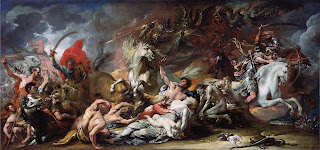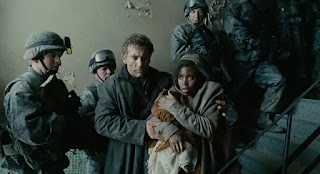Apocalyptic Archetype:Exploring Cataclysmic Themes in Movies
Personal Information:-
Name:- Aakash Chavda
Batch:- M.A. Sem 2 (2023-2025)
Enrollment Number:- 5108230011
E-mail Address:- aakashchavda637@gmail.com
Roll Number:- 1
Assignment Details:-
Topic: Apocalyptic Archetype: Exploring Cataclysmic Themes in Movies
Paper & subject code:- Paper 109: Literary Theory & Criticism and Indian Aesthetics
Submitted to:- Smt. Sujata Binoy Gardi, Department of English, MKBU, Bhavnagar.
Date of Submission:- 26 April, 2024
Abstract
Apocalyptic imagery is not new to us, it's been around since ancient times, appearing in Christian and Greek myths. A prime example is the Second Coming of Jesus. This paper dives into how movies depict such apocalyptic archetypes, focusing on violent and destructive themes. By looking at a range of films from different genres, time periods, and cultures, we explore how cataclysmic events shape storytelling and engage audiences. We'll analyze narrative structures, visual symbols, and characters to reveal the deeper meanings and cultural importance in apocalyptic cinema. This research helps us understand how movies portray the fear of societal collapse, renewal, and existential dread.
Keywords: Apocalypse, myth, violence, archetype
Introduction: Apocalyptic Imagery Across Myths
Since the dawn of human civilization, the concept of the apocalypse, the catastrophic destruction and end of the world has pervaded the myths, stories and belief systems across cultures. Cyclical visions view the world as being created, destroyed and reborn repeatedly in an endless cycle of birth, death and renewal. The Hindu concept of cyclical yugas, the Mayan great cycles, and the Greek myths of the four races of man exemplify this idea of recurring apocalypses and rebirths of the cosmos. A common theme is the moral and spiritual decline of humanity over ages, leading to their downfall and the world's destruction by divine forces, only to start anew.
Flood Imagery
One of the most disastrous apocalyptic myths across cultures is that of a great primordial flood that wipes out humanity. From the Biblical story of Noah to the ancient Mesopotamian epics and the Hindu puranic tales. The flood serves as a cleansing force to destroy a corrupt humanity and prepare for a fresh start. Invariably, the myths include the presence of survivors who carry forward life into the new world cycle.
War Between Gods and Evils
linear apocalyptic narratives depict a singular, definitive end of humanity after which there is no resurrection or renewal possible. Religions like Zoroastrianism, Norse mythology and Christianity prophesied one final, cataclysmic battle between the forces of good and evil that will bring about the absolute termination of the current world order.
A common element is the presence of a messianic savior figure like the Saoshyant in Zoroastrianism or Jesus in Christianity who triumphs over the forces of darkness and evil to usher in a new paradisiacal realm or age after the apocalypse. The motif of the final judgment separating the virtuous from the wicked is also widespread.
Hindu Apocalyptic Myth: Kalki Avatar
Kalki, seen as a sign of the end of the world in Hindu religion, is believed to bring destruction when people no longer practice religion or understand the rituals involved, even just superficially. Kalki is believed to be the final incarnation of Hindu God Vishnu, who will come at the end of Kali-yuga and end humanity.
“like a comet and carry a terrifying sword for bringing about the annihilation of the wicked barbarian men at the end of the Kali-yuga”
While the specific cosmological causes and mechanisms ascribed to the apocalypse vary across cultures from divine retribution to scientific cataclysms like meteorite impacts. The underlying psychological drivers seem to be the human desire to rationalize and make sense of permanent change and flux in the world. Apocalyptic imagery allows societies to periodically "reboot" their belief systems to adapt to new circumstances according to prevailing changes.
This obsession with narratives of the "end times" has persisted into modernity, reflected in popular literature of science fiction, films, television shows and new media that tap into contemporary anxieties, it can be climate change, nuclear warfare, pandemics, or cosmic disasters. Though the modes and mediums have changed, the root of the apocalyptic desire seems to stem from the timeless human longing to find meaning and dramatize the great uncertainties that shroud our origins and eventual fate as a species.
While ancient apocalyptic tales invoked mystical rituals and deities, modern secular societies look to science to battle perceived existential risks. Yet the fundamental psychology driving these narratives appears to be archetypal and enduring.
Apocalyptic and Post-Apocalyptic Movies
The science fiction genre has long delved into the idea of the end of human civilization, portraying life after society collapses due to natural disasters, wars, or even zombie apocalypses. In recent years, post-apocalyptic movies have particularly captivated audiences, demonstrating glimpses of both the world's demise and the emergence of new challenges that test humanity's resilience and adaptability. These films depict survivors struggling to stay alive in a world turned upside down, showcasing the ingenuity and fortitude required to navigate through the rubble of civilization. With a surge in post-apocalyptic storytelling, especially in the 2000s, there's no shortage of captivating movies that explore the depths of human endurance amidst chaos and destruction. As summer approaches, these cinematic tales serve as both cautionary tales and thrilling adventures, inviting viewers to ponder the fragility of our existence while reveling in the triumph of the human spirit.
While many assume that apocalypse is generally associated with zombie invasions or alien attacks, the truth is that catastrophic events like climate change, pandemics, warfare, and societal collapse can also bring about the end of the world. Introducing realistic themes into apocalyptic films adds depth and resonance, drawing viewers closer to the characters and heightening the emotional impact of the story.
Fascination With Zombies
Recently, the zombie genre has become really popular in movies and TV shows. They often show a world after it's been destroyed by zombies, with humans fighting to survive. These movies change over time, showing what people are afraid of, how technology is changing, and what's popular in society.
The Walking Dead
In "The Walking Dead," Andrew Lincoln portrays Rick Grimes, a police officer thrust into a world ravaged by a zombie apocalypse. The zombies themselves range from grotesque to horrifying, with their varying states of decay serving as a haunting reminder of the world's collapse. "The Walking Dead" delivers a gripping narrative that keeps us on the edge of our seats, eagerly anticipating each new twist and turn in this post-apocalyptic saga.
World War Z
Yet another zombie movie, this film explores the start of a zombie apocalypse. This movie presents horrific world of zombie attacks. It draws inspiration from "Contagion" in exploring global transmission fears.
Children of Men
This is a special apocalypse movie because of its realistic plot line . It doesn't have big monsters or zombies. Instead, it's all about humanity. In the movie, women are no longer fertile, which means extinction of humankinds , which puts humanity in danger of dying out because it's so hard for anyone to get pregnant.
Mad Max: Fury Road
"Mad Max: Fury Road" takes viewers to a post-apocalyptic world where humanity's self-destruction has led to a brutal dictatorship. Despite the grim setting, the film offers a cathartic escape through its high-octane action and practical effects.
What to Learn From These Movies?
Apocalyptic movies reflect society's deep fears and concerns. They show scenarios where human civilization could end. Through these apocalyptic stories, we can understand what we are afraid of losing and what we value the most.
Some apocalyptic movies warn us about our own inventions and technological advancement that are becoming too powerful and harming us. Films like Matrix and Children of Men caution that if we go too far beyond natural limits and create advanced lifeforms, they may one day overpower humans. These movies reveal our worries about losing control over our creations. Other movies show humanity coming together against common threats like aliens or zombies. Despite differences, these films suggest we can unite as a species in an existential crisis. The zombie genre has become very popular, perhaps because zombies are a familiar, consistent threat that allows us to imagine surviving together.
However, some apocalyptic films remind us that human society is fragile and could collapse from within. Movies like Mad Max: Fury Road and Contagion show the real threat is our own distrust, selfishness and capability for cruelty when fighting for survival. They warn that our civilized behavior could quickly disappear in dire situations, revealing the darker side of human nature.
Conclusion
Exploring various cataclysmic and extinction themes in movies like "Children of Men," "Mad Max: Fury Road," and "The Matrix," we witness the various ways in which humanity struggles in the face of apocalyptic scenarios. These films offer a poignant reminder of the fragility of society and the resilience of the human spirit. Whether it's the infertility crisis in "Children of Men," the post-nuclear barrenness in "Mad Max: Fury Road," or the illusion of reality in "The Matrix," each movie offers unique insights into survival, hope, and the quest for redemption amidst chaos. Through these apocalyptic archetypes, viewers are both challenged and inspired to contemplate the consequences of our actions and the potential for renewal in the face of adversity and hard times.
Wordcount: 1526
References
“The 40 Essential Zombie Movies to Watch.” Rotten Tomatoes, https://editorial.rottentomatoes.com/guide/essential-zombie-movies/. Accessed 25 April 2024.
Blackburn, Alix. “Alix Blackburn | ScreenRant.” Screen Rant, https://screenrant.com/author/alix-blackburn/. Accessed 25 April 2024.
Carletti, Fabiola. “What doomsday films tell us about ourselves.” CBC, 20 December 2012, https://www.cbc.ca/news/entertainment/what-doomsday-films-tell-us-about-ourselves-1.1130519. Accessed 25 April 2024.
Mitra, Ritwik. “25 Best Post-Apocalyptic Movies Of The 21st Century (So Far), Ranked.” Game Rant, 4 March 2024, https://gamerant.com/best-post-apocalyptic-movies-ranked/. Accessed 25 April 2024.
Moniz, Ariel. “The End of Days: Tales of Apocalypse Across Time and Space.” 2014. University of Hawai‘i at Hilo, https://hilo.hawaii.edu/campuscenter/hohonu/volumes/documents/TheEndofDays-TalesofApocalypseAcrossTimeandSpaceArielMoniz.pdf. Accessed 25 April 2024.
Sullivan, Kerry. “When Kalki the Destroyer Descends, the Apocalypse Begins.” Ancient Origins, 24 October 2019, https://www.ancient-origins.net/myths-legends/when-kalki-destroyer-descends-greed-corruption-war-destruction-and-apocalypse-006545. Accessed 25 April 2024.





.jpg)







